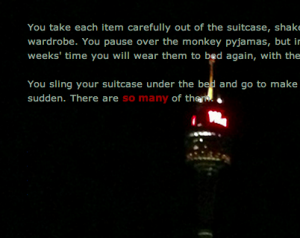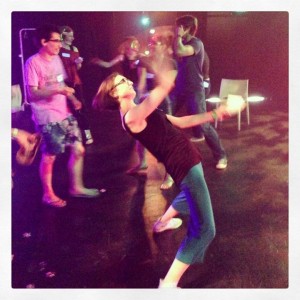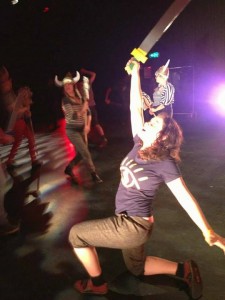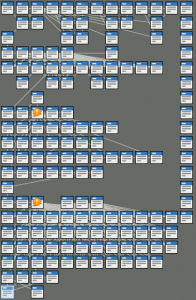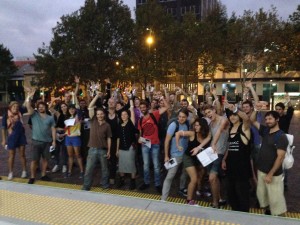
Last night I joined Grant and Bill Cohen in running a city-wide chase game called Journey to the End of the Night. It’s a US system, and it’s the first time it’s been run in Sydney, so we started off fairly low-key; in the end we had about 20 crew and about 60 players, which suited us pretty well. I ran & walked (mostly walked, admittedly) somewhere in the region of 7 miles around the city, coordinating runners by text message as we hunted down the players, and in the end we had 11 survivors who got round every checkpoint without being caught. It was enormous fun.
This is why it worked well.
The system
Journey is a very efficient system. It’s a simple, clear, uncomplicated ruleset that you can explain in a few words: run around all the checkpoints in any order, then get to the endzone, without being caught. If you’re caught, you have to chase the players. Catch three, and you can respawn back as a runner. Clean and crisp.
The core of the game is uncomplicated fun. It’s enormous fun to run around the city after dark with your friends hiding from people, especially when you know you have support nearby if you need it. It’s fun for fit people who enjoy running, and it’s also fun for people who like hiding and sneaking or thinking laterally about the logistics of things – it’s not always the best runners who win, it’s those who can avoid being caught. It’s a solid system that lends itself to all sorts of locations, and – because of the exponential nature of the catching system – it scales very well between small and large groups. Most of the success or failure of the game is down to the route you pick.
The route
We spent a lot of time ahead of the game scoping out potential checkpoint sites and creating a good route. There’s lots of variety in the areas we eventually picked – even if you don’t see a chaser for the whole time, you run through a mix of heavily-populated areas where anyone might be a chaser, and quiet back streets where there might be one around any corner. We picked checkpoints that weren’t easy to chain with public transport, though a couple of guys took an unorthodox ferry-and-tram route to save themselves some time. (I’m still impressed they did that.)
The checkpoints themselves were sometimes a little tricky. Two in particular gave us problems with spawn camping – player chasers lurking on the obvious entry and exit routes and ambushing runners, which wasn’t massively fair. It’s almost impossible to make rules to mitigate that sort of behaviour, so you have to rely on level design; when you don’t have the ability to manipulate levels yourself, because you can’t actually remodel traffic intersections just for your own games, sometimes you’re stuck with less-than-ideal areas. A good checkpoint is one that’s small but completely open on all sides, rather than large but with only one or two useful ingress routes. The best checkpoints are in the middle of huge open spaces with lots of potential cover, so players end up ducking in and out of hedges, trees and play equipment just in case there are chasers around.
Andy

Speaking of which: our star chaser, Andy, was a one-man army who managed to create exactly the right feeling of paranoia and fear right from the start. He’s a long distance runner. He went running before the game started, for fun. By the end of the night he’d acquired the nickname ‘Terminator’. One man hid under a car to escape him. Another vaulted into a construction site. Some people recruited passers-by as camouflage to help avoid his gaze. He was so fast and had so much stamina that hiding or outwitting him were your only options as players: simply outrunning him would never work. He was astonishing.
And from a crew perspective, he was invaluable too: he was checking in at regular intervals, letting us know which way players were scattering so we could set up less-manoeuvrable chasers to give them a good run. He was happy to go where he was needed most, and responsive to instructions. And, despite being the scariest thing in the game, he only caught two runners: the rest just had very near misses. Andy was incredible.
Froth
It’s been too long since I ran the sort of game that finishes up with froth. At the end of the night, we set up a couple of tables on Observatory Hill, a tricky-to-reach but beautiful park with gorgeous views across the harbour. By the time I got there most of the survivors had arrived and crew were still trickling in from across the city. I walked in to be surrounded by stories: the making of mythologies, happening around me. Many of them about Andy.
Froth is a LARP slang term for discussing events during a game, but out of character, afterwards. It lets you process what’s happened during an event, collaboratively building a single story out of the most exciting moments, turning what can be quite a disjointed experience into a coherent narrative.
GIving people space to froth after a game is one of the most important things you can possibly do. And lots of sporting events do it too: Tough Mudder, for instance, has a superb back-slapping and beer session once the race is over, which is all about frothing over what’s happened to you during your run. You make friends, you meet up with folks you lost on the way, you get to hear the stories of other people’s miraculous successes or so-close failures.

When I walked up to the hill last night, before I’d managed to get a bottle of water and say hi to the other crew, four different runners had already told me a little story of how they escaped a chaser or how they caught one of their friends or what happened when Andy showed up.
The players
People are amazing. People turned up last night to a random free event, excited to see what happens next, willing to suspend their disbelief and explore and create together. People turned up happy to play – playing to win, playing to have fun, playing to see what happened next.
That goes for the crew, too. We had a superb volunteer crew, all happy to take hours out of their Saturday nights to run around, sit about, sign papers, chat to players, and chase them around the city. We quite literally could not have run the game without those people, and they all made it better for the players by being so committed to maintaining the playful nature of the evening.
One woman got caught early on and then tried to head her friend off by taking a shortcut to where she knew he’d have to go. Then they had a tickle fight – he won, and left her giggling on the floor as he sprinted away into the darkness. With players like that, the game can’t help but be fun to run.
What’s next?
We’re going to be running Journey again in Sydney, I hope – there’s definitely appetite for it. But first, Grant and I are running a new game, Spirits Walk, in Melbourne in collaboration with Pop Up Players, on March 7, 8 and 9. You can reserve a space here.
